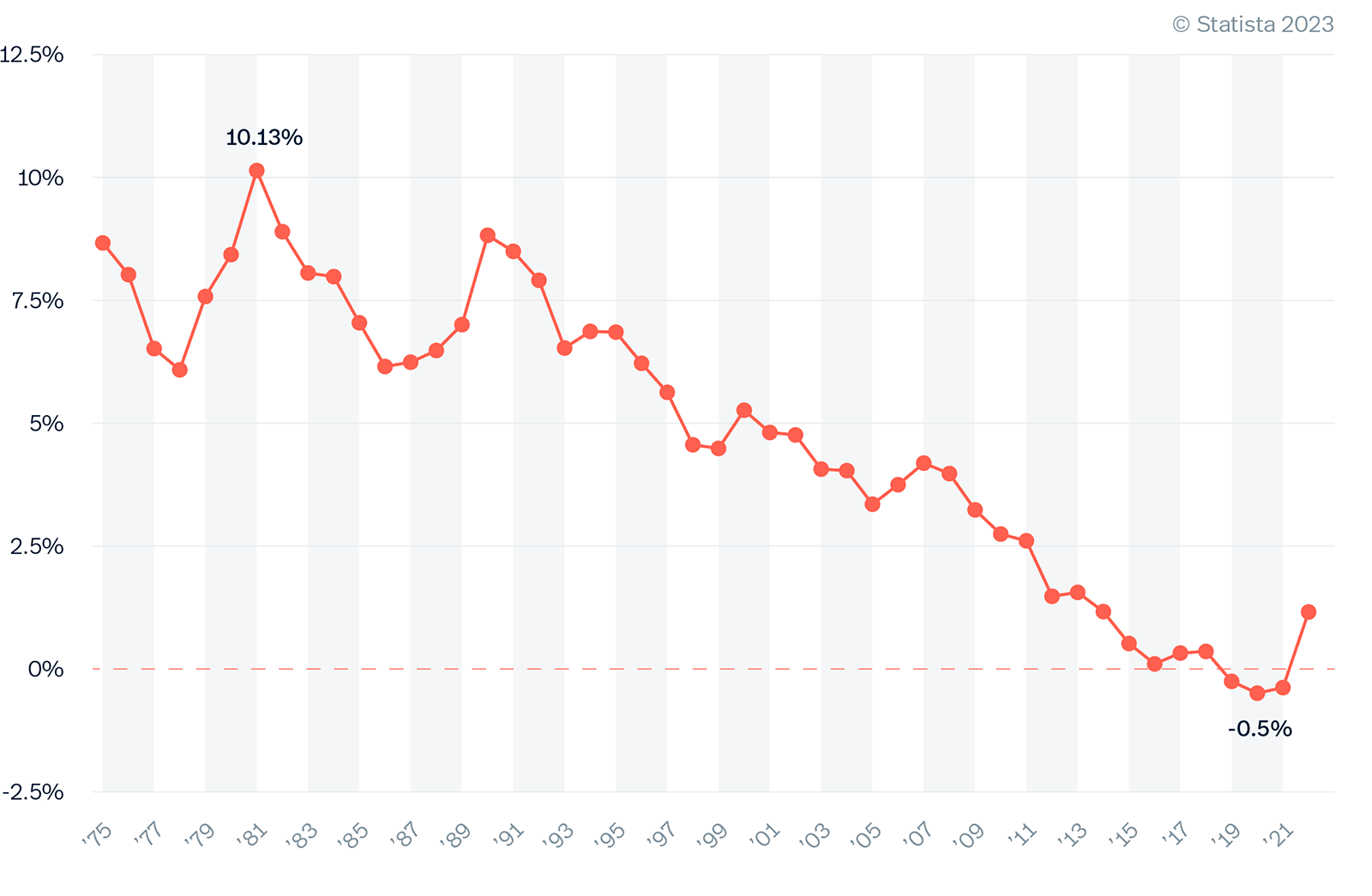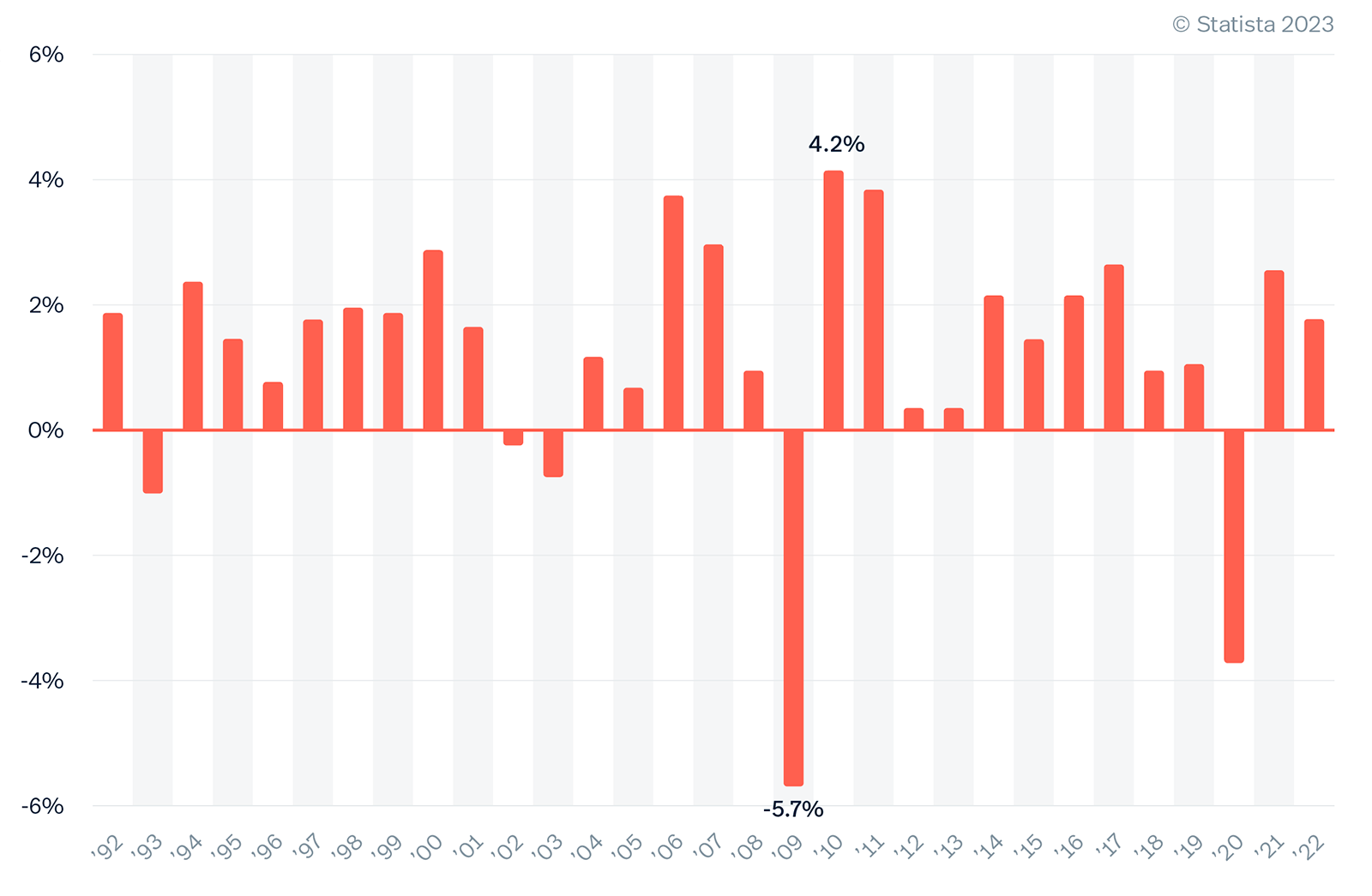By
Dr. Walter Demmelhuber
The role of Executive Board members has evolved significantly over the last ten years, with changing business landscapes and economic conditions. This article aims to explore how the competence requirements have transformed during two distinct periods: 2013–2018, characterised by growth, and 2020–2022, marked by crisis. By comparing these two periods, we can gain insights into the shifting expectations and skills demanded of executives in times of prosperity versus times of adversity.
Competence requirements during the growth period (2013-2018)
The period between 2013 and 2018 was largely characterised by economic expansion and stability in many regions. Low interest rates further fuelled an expansion strategy of many companies based on heavy investment.
Development of Interest Rates

Source:
Statista: Entwicklung des Kapitalmarktzinssatzes in Deutschland in den Jahren von 1975 bis 2022. Retrieved from: https://de.statista.com/statistik/daten/studie/201419/umfrage/entwicklung-des-kapitalmarktzinssatzes-in-deutschland/
During this growth period, the competence requirements for Executive Board members tended to emphasise the following key areas:
- Strategic Vision and Business Development: Executive Board members were expected to possess a forward-thinking strategic vision to identify emerging opportunities and drive business growth. They needed to formulate and execute long-term plans, explore new markets and product/service offerings to expand the company’s reach.
- Financial Acumen and Risk Management: As organisation sought to capitalise on the favourable economic climate, Executive Board members needed to demonstrate strong financial acumen. They were responsible for managing financial resources efficiently, optimising profitability and implementing effective risk management strategies.
- Leadership and Team Building: In the growth period, Executive Board members were required to provide strong leadership and foster a positive corporate culture. They needed to build high-performing teams, nurture talent and motivate employees to achieve organisational goals.
- Innovation and Adaptability: Rapid technological advancements and changing customer expectations demanded Executive Board members who were innovative and adaptable. They needed to embrace emerging technologies, promote a culture of innovation and ensure that the organisation stayed ahead of the curve.
Development of BIP in Germany

Source:
Statista: Veränderung des realen Bruttoinlandsprodukts (BIP) in Deutschland gegenüber dem Vorjahr von 1992 bis 2022. Retrieved from: https://de.statista.com/statistik/daten/studie/2112/umfrage/veraenderung-des-bruttoinlandprodukts-im-vergleich-zum-vorjahr/
Competence requirements during the crisis period (2020-2022)
The global COVID-19 pandemic in 2020, the Russian war in the Ukraine starting in 2022 and the subsequent economic downturn marked the crisis period from 2020 to 2022. During this challenging phase, the competence requirements for Executive Board members underwent significant shifts:
- Crisis Management and Resilience: The crisis necessitated strong crisis management skills. Executive Board members were expected to swiftly respond to the evolving situation, making tough decisions to protect the organisation’s viability. Resilience and the ability to navigate uncertainty were paramount.
- Cost Control and Efficiency: With economic uncertainty and reduced revenue streams, Executive Board members had to focus on cost control and efficiency. They needed to identify areas of waste, streamline operations and optimise resource allocation to maintain financial stability.
- Digital Transformation and Remote Work: The pandemic accelerated the need for digital transformation and remote work capabilities. Executive Board members had to ensure the organisation could adapt to remote operations, leverage digital tools and maintain productivity and connectivity in a virtual environment.
- Stakeholder Communication and Transparency: During the crisis period, effective communication with stakeholders became crucial. Executive Board members were required to provide transparent updates on the company’s financial health, mitigation strategies and contingency plans to maintain stakeholder confidence and trust.
The competence requirements for Executive Board members have evolved significantly, reflecting the changing dynamics of the business environment. The growth period of 2013-2018 emphasised strategic vision, financial acumen, leadership and innovation. However, the crisis period of 2020-2022 demanded crisis management skills, cost control, digital transformation and effective stakeholder communication. By recognising these shifts, organisations can better align their board selection and development processes with the specific demands of each period, ensuring the right skill sets are in place to steer the company successfully, regardless of the prevailing economic conditions.
The question of whether to promote an internal candidate or hire an external candidate for the Executive Board is complex and depends on a whole host of factors. There is no one-size-fits-all answer, as each situation is unique and requires careful consideration. Both internal and external candidates bring distinct advantages and challenges. Let’s explore the benefits and considerations of each option:
Promoting an Internal Candidate:
- Institutional Knowledge and Understanding: Internal candidates often have a deep understanding of the company’s culture, operations, and industry dynamics. They possess institutional knowledge and historical context that can be invaluable in decision-making processes.
- Loyalty and Commitment: Internal candidates who have been with the company for a significant period may have demonstrated loyalty and commitment to the organisation’s long-term success. Their dedication and alignment with the company’s values and objectives can contribute to stability and continuity.
- Motivation and Morale Boost: Promoting from within can boost employee morale and motivation, as it signals opportunities for career growth and recognition of talent. This can foster a positive work environment and inspire other employees to strive for advancement.
- Reduced Onboarding and Transition Time: Internal candidates are already familiar with the company’s processes, systems and people, which can result in a faster transition and reduced onboarding time compared to external candidates.
Considerations for Internal Candidates:
- Limited External Perspectives: Internal candidates may have limited exposure to external industry trends and fresh ideas. This can potentially lead to a lack of diverse perspectives and innovative thinking.
- Risk of Stagnation: If an organistion relies too heavily on internal promotions without considering external talent, it may miss out on new skills, experiences and perspectives that could drive growth and innovation.
Hiring an External Candidate:
- Fresh Perspectives and Expertise: External candidates bring a fresh set of experiences, perspectives and expertise from different organisations and industries. They can introduce new ideas, challenge existing norms and drive innovation.
- Expanded Networks and Relationships: External candidates often have broader networks and industry connections that can benefit the organisation in terms of partnerships, collaborations and business development opportunities.
- Objective Evaluation and Independence: External candidates can provide an objective evaluation of the company’s operations, strategies and performance. Their independence can facilitate unbiased decision-making and enhance governance practices.
Considerations for External Candidates:
- Cultural Fit and Integration Challenges: It can take time for an external candidate to adapt to the organisation’s culture and build relationships with existing employees. Ensuring a cultural fit and supporting their integration into the company is crucial for success.
- Disruption and Employee Morale: Hiring an external candidate for a top leadership position may create some disruption and potential resistance from internal employees who were vying for promotion. Managing employee morale and communication during such transitions is essential.
Conclusion
The decision to promote an internal candidate or hire an external candidate for the Executive Board requires a thoughtful evaluation of the specific circumstances, company culture, strategic goals and available talent pool. Both options have advantages and considerations that must be weighted.
Growth cycle competencies of an Executive Board Member are typically learned inside the company or coming from a competitor or customer which favours internal candidates. Crisis and restructuring competencies are typically gained in a wide variety of companies with shorter mandates to develop a reliable toolbox and profound knowledge.
Whereas in growth periods Leadership Development Services play a prominent role when promoting internal candidates, Executive Search Services are requested to find external candidates with repeated restructuring experience. It is not unsurprising that Executive Board members selected for growth did not see the crisis coming and a significant number of companies went unprepared into the storm.
Part of the challenge of finding competent Executive Board members for crisis periods are that crisis periods (in the past) were shorter and fewer than growth periods. Additionally, experiences should be obtained from several mandates. Therefore, such Executive Board members are a rare species to encounter.
Ultimately, the organisation should strive for a balanced approach, considering a mix of internal promotions and external hires to ensure a diverse range of skills, experiences and perspectives within its Board of Directors.

